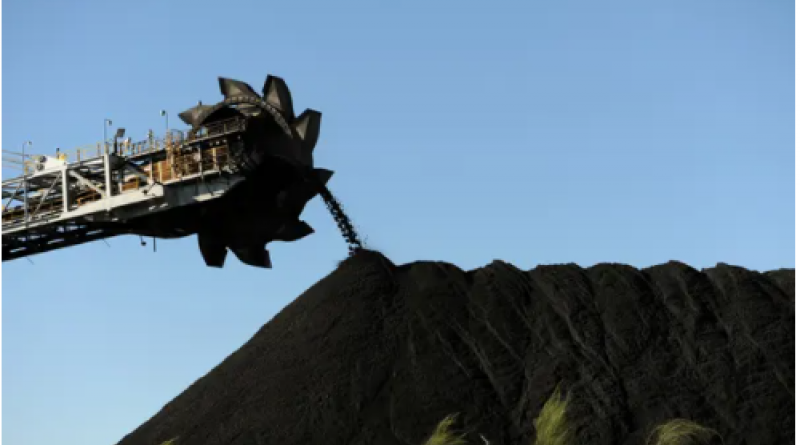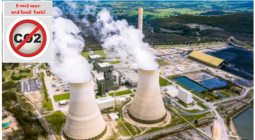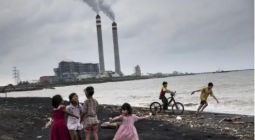Australian coal burnt overseas creates nearly twice the nation’s domestic emissions.

New data comes amid warning that world’s growing awareness of coal exports’ impact risks further damaging Australia’s reputation on climate.
Emissions from coal mined in Australia but exported and burnt overseas were almost double the nation’s domestic greenhouse gas footprint in 2020, according to new data.
Australia and Indonesia were the biggest exporters of coal for making steel and burning in power stations, together accounting for 59% of the world’s seaborne coal market.
When countries report their national emissions to the United Nations, only fossil fuels burned domestically are counted. But the impacts of the CO2 on the climate are the same, whether they are burned in Australia or overseas.
Earlier this week the government’s latest emissions data showed greenhouse gas emissions had dropped to a 30-year low of 499Mt of CO2e, thanks mostly to the Covid-19 pandemic and increasing amounts of renewable energy replacing coal.
But the new data, compiled by the UK-based pro-renewables thinktank Ember, says emissions from Australian coal burned overseas released 895Mt of CO2 into the atmosphere, with 460Mt of that coming from coal used in power stations.
Australia has been coming under increasing international and domestic pressure to announce more ambitious climate targets ahead of the next major climate talks in Glasgow in November.
At the same time, state governments continue to release and promote more fossil fuel extraction despite an International Energy Agency report warning that new projects need to halt if the world is to have a chance to keep global heating to 1.5C
Ember analyst Nicolas Fulghum said that while profits from coal exports flowed to exporting countries, “the environmental impact is shipped overseas”.
Eight out of the 10 largest coal ports by volume were in either Australia and Indonesia.
Newcastle remains the world’s largest coal export port, with 155Mt – or 12% of all the world’s seaborne coal – coming from the New South Wales hub. Hay Point in Queensland is the second-largest coal port, exporting 100Mt of coal in 2020.
Australia’s top three customers for thermal coal in 2020 were Japan (67Mt), China (29Mt) and Korea (28Mt), according to the data.
All three countries have pledged to reach net-zero greenhouse gas emissions – Japan and Korea by 2050 and China by 2060.
Bill Hare, the chief executive and senior scientist with Climate Analytics and a veteran of international climate negotiations, told the Guardian the new data was in line with his own consultancy’s research on export emissions.
He said the data showed Australia was “highly exposed” to the impacts of planned CO2 cuts in countries currently buying the coal.
“That’s an economic risk and a strong signal.”
He said that as more people around the world started to understand the impact of Australia’s exports on the global climate, this risked further damaging the country’s already poor reputation on climate action.
“This is going to translate into some fundamental questions about Australia’s economy. If we’re so exposed to carbon and the global markets, that’s going to feed into a broader view of Australia’s economy as being underpinned by a reliance on fossil fuels.”
He said historically Australia’s fossil fuel export industry was largely ignored during international negotiations because there were many countries that profited from fossil fuels.
But he had noticed a shift at the most recent talks in Madrid in 2019 when some national delegates had started to “point fingers” in frustration at major fossil fuel exporters, including Australia.
“These sorts of numbers won’t help Australia’s position at all” at the coming talks scheduled for Glasgow, Hare said.
Australia has promised to release a long-term greenhouse gas emissions strategy before those talks.
Morrison told an April climate summit hosted by the US president, Joe Biden, that future generations would “thank us not for what we have promised but what we deliver”.
Morrison has said Australia wants to reach net-zero “as soon as we possibly can” but has resisted pressure to promise a mid-century target.
The government has said it is concentrating on a technology-led response to cutting emissions, but has also pushed for a “gas-led recovery” from the economic impacts of the Covid-19 pandemic.
Australia’s coal and gas industry has complained to an ongoing parliamentary inquiry that it is finding it harder to gain financial backing and insurance for projects.
2 June 2021
The Guardian





